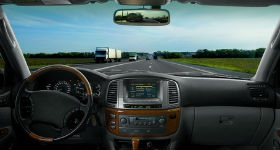Earlier this year Jaguar announced they were working on an augmented reality system for their cars, and last Sunday BMW’s Mini organization—using Qualcomm’s Vuforia—announced a competing idea. Both promise to vastly improve safety and convenience, but their approaches to this next frontier of driving are very different. Be aware that augmented reality, or placing virtual elements in real-world views, is an interim step to self-driving cars, and should help the car drivers of today better interface with the self-driving cars of tomorrow.
Let me walk you through it.
Jaguar vs. Mini
Jaguar is showcasing a system that uses the windshield and A-Pillars (the pillars that frame the windshield) as a display. The big advantage is you don’t have to wear anything for it to work and that means that you can just get into the car and drive. The disadvantages are that windshields are one of the most vulnerable parts of the car, something that I was reminded of when a rock took a chip out of my brand new windshield on my drive out to see the Mini demonstration in San Francisco.
This could take the cost of the windshield replacement up significantly because windshields vary car to car and embedding technology in them could increase their cost three or four times what they are today, plus add to the installation because the windshield now needs to be electrically connected to more systems (currently they can have heating coils in them and antennas, each typically adding around $200 to the cost of what is now around a $900 replacement expense).
Additionally, all of the driver information isn’t likely to be that interesting to the passenger, who also has to see it, and parking assist (being able to see curbs using the car’s cameras) isn’t intuitive because the view is down and not out.
Mini is going a very different route: using Qualcomm’s Vuforia AR technology they are showcasing a set of augmented reality glasses (which we hope to see more of at the Wearable Tech Expo event in July) that provide the same information. The disadvantage is that you have to wear the glasses which can also be broken or lost (though you can connect them to your phone for tracking). However, now only the driver sees the navigation information and a second set of glasses worn by the passenger might contain entertainment, games (I think a game that allowed you to have imaginary weapons or use one of the street view applications to virtually zoom up and down streets, or see information about the things you were passing could be very interesting).
 Image via Shutterstock
Image via Shutterstock
They would also work outside of the car, so you could use them to more safely navigate the walk to and from your car, keeping your eyes focused on where you put your feet rather than on your phone. In effect the technology could come with you, and you might even translate it to a bicycle or motorcycle (in this case BMW Motorcycle) allowing you to extend the utility of the glasses beyond the car.
Parking is easier because they interface with the car’s cameras allowing you to look through the car at curbs, avoiding the cost of taking out an expensive wheel (which I’ve done a number of times).
Speakers in the glasses could take the place of a Bluetooth ear piece allowing you to take calls both in and out of the car more privately, and alerts would show up in the glasses for message notification—which you could have read to you—or for caller identification.
Both technologies should have auto diming so you don’t have to wear sunglasses, and should rapidly move to hardened glass like Corning Gorilla Glass 4 to reduce the costs related to breakage. Another issue with the windshield is that Corning doesn’t yet have a formulation that works on cars but they are working to create one in their labs.
AR in the Car to Self-Driving
Both systems could be tied into self-driving car networks so you could see the same kinds of advanced warnings that self-driving cars get with regard to accidents, pending system failures, drivers operating under the influence, or road hazards. This should allow drivers using them to better integrate into the coming self-driving world and avoid at least some of the problems that will otherwise result.
Sensors for self-driving cars will precede the approval for this technology and AR will allow you to more intuitively use these sensors until you can have the car eventually drive itself. This should allow human drivers and cars equipped with this technology (which can be retrofitted) to stay on the road longer after self-driving autonomous vehicles becomes more standard.
Wrapping Up
We are moving rapidly to provide better interfaces between people and technology and this is only one example of that trend. While AR will be an interim step between how we drive today and how computers will drive us tomorrow, it will likely be a lasting one because the other advantages with regard to giving us information, keeping us safer and more aware of our surroundings, and keeping us more entertained will fuel this technology even after self-driving cars become the norm. One final example is they could give us a horizon to look at in conjunction with extras and entertainment, reducing the probability of motion sickness in self-driving cars.
Edited by
Dominick Sorrentino